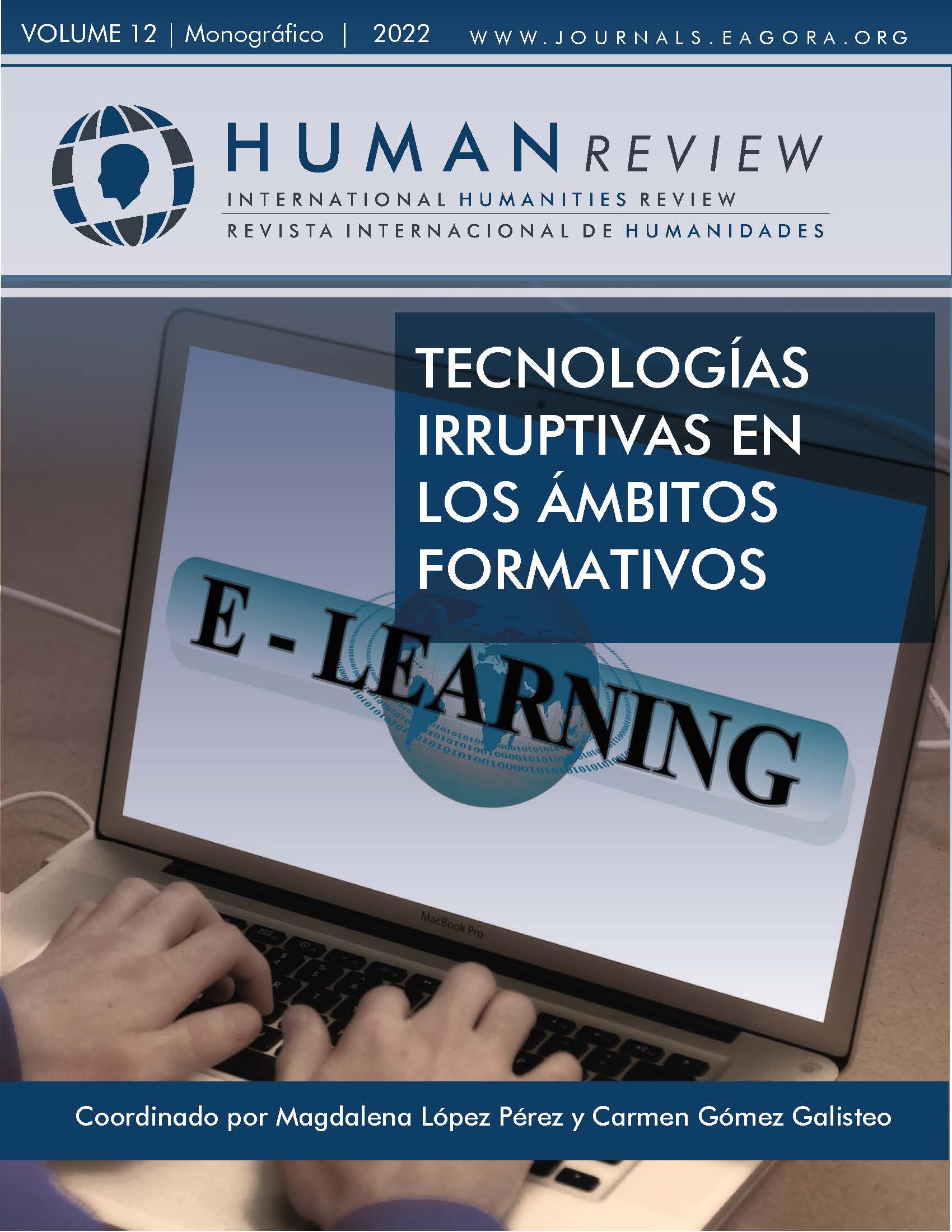Impact and perception of learning by teaching activities among university students
DOI:
https://doi.org/10.37467/revhuman.v11.3963Keywords:
Higher Education, Learning by Teaching, Active teaching methods, Collaborative learning, Student centered learning, Teaching-learning process, Students’ perceptionAbstract
Teaching methodologies have been adapting to changes in society, from learning in which the student plays a more passive role and is limited to listening to a lecture, to more active learning, using methodologies such as active learning, flipped learning, learning by teaching, role play, etc.
This research analyses the students’ perception of their learning with the use of the Learning by Teaching methodology, working with a sample of 196 students of Bachelor’s Degrees in Business Administration and Management, Marketing and Digital Business.
References
Annis, L. F. (1983). The processes and effects of peer tutoring. Human Learning: Journal of Practical Research & Applications.
Barkley E. F., Cross P. y Mayor C. H. (2007). Técnicas de aprendizaje colaborativo. Manual para el profesorado universitario. Ed. Morata
Bargh, J. A., & Schul, Y. (1980). On the cognitive benefits of teaching. Journal of Educational Psychology, 72(5), 593. DOI: https://doi.org/10.1037/0022-0663.72.5.593
Biggs, J. B. (1987). Student Approaches to Learning and Studying. Research Monograph. Australian Council for Educational Research Ltd., Radford House, Frederick St., Hawthorn 3122, Australia.
Blair, C. (2008). The learning pyramid. Documento de Internet disponible en: http://studyprof. com/blog/about-2/Breen, M. y Candlin, C.(2001).«The essentials of a communicative curriculum in language teaching». En Innovation in English Language Teaching. Eds. y. Londres: Routledge, 9-26.
Cohen, P. A., Kulik, J. A., & Kulik, C. L. C. (1982). Educational outcomes of tutoring: A meta-analysis of findings. American educational research journal, 19(2), 237-248. DOI: https://doi.org/10.3102/00028312019002237
Cortese, C. G. (2005). Learning through teaching. Management Learning, 36(1), 87-115. DOI: https://doi.org/10.1177/1350507605049905
De Obesso, M. y Núñez-Canal, M. (2020). El modelo educativo híbrido: una respuesta necesaria de la enseñanza universitaria a partir de la Covid-19. Recuperado de: https://www. researchgate. net/deref/http% 3A% 2F% 2Fdx. doi. org% 2F10, 13140.
Díaz, F. J., Harari, I., & Amadeo, A. P. (2012). Propuesta sobre aprender enseñando: desarrollo de un curso a distancia sobre Accesibilidad Web en manos de alumnos. En VII Congreso de Tecnología en Educación y Educación en Tecnología.
Durán, D. (2017). ¿Se puede aprender enseñando?. Evidencias científicas e implicaciones educativas. Aula de innovación educativa, (259), 35-40.
Fantuzzo, J. W., King, J. A., & Heller, L. R. (1992). Effects of reciprocal peer tutoring on mathematics and school adjustment: A component analysis. Journal of Educational Psychology, 84(3), 331. DOI: https://doi.org/10.1037/0022-0663.84.3.331
Fry, H., Ketteridge , S., & Marshall, S. (Eds.). (2008). A Handbook for Teaching and Learning in Higher Education: Enhancing Academic Practice. Routledge DOI: https://doi.org/10.4324/9780203891414
Gómez, A. y Monfort, A. (2017). Breve aproximación a las metodologías docentes para su aplicación en el aula. Manuscrito no publicado. ESIC Business and Marketing School. Madrid.
Goodlad, S., & Hirst, B. (1989). Peer Tutoring. A Guide to Learning by Teaching. Nichols Publishing, PO Box 96, New York, NY 10024.
Gutiérrez Pozo, A. (2021). Enseñar el aprender. Pidiendo una educación socrática desde dentro. DOI: https://doi.org/10.51359/2448-0215.2021.249623
Heredia, P. (2020) https://www.inesem.es/ Blog consultado 05/06/22
Hernández I., Lay N. Herrera H., Rodríguez M. Estrategias pedagógicas para el aprendizaje y desarrollo de competencias investigativas en estudiantes universitarios. Revista de Ciencias Sociales, 27(2), 242-255.
Huerta Córdova, V., Duran Gisbert, D., & Castellanos Lemus, P. G. (2016). Aprender enseñando arte: cómo convertir la escasez de recursos en oportunidades de aprendizaje. Revista iberoamericana de educación. DOI: https://doi.org/10.35362/rie722105
Martínez M. (2021) LAS CÁPSULAS DE APRENDIZAJE SABEN MEJOR SI LAS CREAN LOS PROPIOS ALUMNOS. Revista Educ@rnos
McCrindle, M. (2021). Generation Alpha. Hachette UK.
Melero, M. A., & Fernández Berrocal, P. (1995). El aprendizaje entre iguales: el estado de la cuestión en Estados Unidos. La interacción social en contextos educativos. Madrid: Siglo XXI.
Oakley, B. A. (2014). A mind for numbers: How to excel at math and science (even if you flunked algebra) algebra). TarcherPerigee
Robinson, D. R., Schofield, J. W., & Steers-Wentzell, K. L. (2005). Peer and cross-age tutoring in math: Outcomes and their design implications. Educational Psychology Review, 17(4), 327-362. DOI: https://doi.org/10.1007/s10648-005-8137-2
Rohrbeck, C. A., Ginsburg-Block, M. D., Fantuzzo, J. W., & Miller, T. R. (2003). Peer-assisted learning interventions with elementary school students: A meta-analytic review. Journal of educational Psychology, 95(2), 240. DOI: https://doi.org/10.1037/0022-0663.95.2.240
Servicio de Innovación Educativa de la UPM (Julio 2020). Learning By Doing. Madrid: Universidad Politécnica de Madrid. Disponible en: https://innovacioneducativa.upm.es/guias_pdi, Consultado el 05/06/2022
Topping, K. J. (1996). Effective peer tutoring in further and higher education. Staff and Educational Development Association.
Topping, K., Duran, D., & Van Keer, H. (2015). Using peer tutoring to improve reading skills: a practical guide for teachers. Routledge. DOI: https://doi.org/10.4324/9781315731032
Torres Carceller A. (2019) Innovación o moda: las pedagogías activas en el actual modelo educativo. Una reflexión sobre las metodologías emergidas. Voces de la Educación, 2019, vol.4, num.8, p.3-16.
Vygotsky, L. S., & Cole, M. (1978). Mind in society: Development of higher psychological processes. Harvard university press.
Wagner, L. I. L. Y. A. (1990). Social and historical perspectives on peer teaching in education. Children helping children, 21-42.
Walberg, H. J., & Paik, S. J. (2006). Prácticas eficaces. Centro Nacional de Evaluación para la Educación Superior, AC.
Watkins, D. (2000). Learning and teaching: A cross-cultural perspective. School Leadership & Management, 20(2), 161-173. DOI: https://doi.org/10.1080/13632430050011407
Weimer, M. (2002). Learner-centered teaching: Five key changes to practice. San Francisco, CA: Jossey-Bass.
Wright, G. B. (2011). Student-centered learning in higher education. International journal of teaching and learning in higher education, 23(1), 92-97.
Zhou, X., Chen, L. H., & Chen, C. L. (2019). Collaborative learning by teaching: A pedagogy between learner-centered and learner-driven. Sustainability, 11(4), 1174. DOI: https://doi.org/10.3390/su11041174
Downloads
Published
How to Cite
Issue
Section
License
Those authors who publish in this journal accept the following terms:
- Authors will keep the moral right of the work and they will transfer the commercial rights.
- After 1 year from publication, the work shall thereafter be open access online on our website, but will retain copyright.
- In the event that the authors wish to assign an Creative Commons (CC) license, they may request it by writing to publishing@eagora.org









